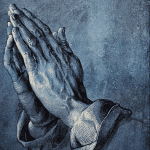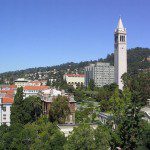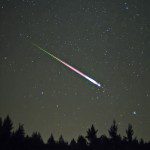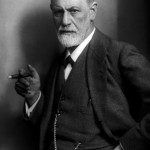
This landscape of “mountains” and “valleys” speckled with glittering stars is actually the edge of a nearby, young, star-forming region called NGC 3324 in the Carina Nebula. Captured in infrared light by NASA’s new James Webb Space Telescope, this image reveals for the first time previously invisible areas of star birth.
Called the Cosmic Cliffs, Webb’s seemingly three-dimensional picture looks like craggy mountains on a moonlit evening. In reality, it is the edge of the giant, gaseous cavity within NGC 3324, and the tallest “peaks” in this image are about 7 light-years high. The cavernous area has been carved from the nebula by the intense ultraviolet radiation and stellar winds from extremely massive, hot, young stars located in the center of the bubble, above the area shown in this image.
A few days ago, I posted some quotations from an interesting paper that I had just read — Stephan A. Schwartz, “Nonlocality and Exceptional Experiences: A Study of Genius, Religious Epiphany, and the Psychic,” Explore 6/4 (July/August 2010): 227-236. My doing so gave such extraordinary joy to the denizens of the Peterson Obsession Board — far over and above any value in the quoted passages — that I think I’ll do so again. (Making others happy makes me happy.) So here are a few more quotations from the article:
First, Schwartz quotes Jessica Utts, a professor of statistics at the University of California, Irvine, who had been asked to review a series of studies of the phenomenon often called “remote viewing,” which is in the same general neighborhood with, if not altogether identical to, the alleged phenomenon that has been called clairvoyance:
Using the standards applied to any other area of science, it is concluded that psychic functioning has been well established. The statistical results of the studies examined are far beyond what is expected by chance. Arguments that these results could be due to methodological flaws in the experiments are soundly refuted. Effects of similar magnitude have been replicated at a number of laboratories across the world. Such consistency cannot be readily explained by claims of flaws or fraud.
The magnitude of psychic functioning exhibited appears to be in the range between what social scientists call a small and medium effect. That means that it is reliable enough to be replicated in properly conducted experiments, with sufficient trials to achieve the long-run statistical results needed for replicability. (cited on 228)
Another passage that intrigued me mentions the work of a team led by the chemist Gregory S. Engel, who was then at the University of California at Berkeley but who is currently at the University of Chicago:
Using femtosecond lasers to follow the movement of light energy through a photosynthetic bacterial cell, Engel et al, quoted in Garfield, “observed the energy traveling along every possible direction at the same time. Instead of following a single trajectory like the electrons on a silicon chip, the energy in photosynthesis explores all of its options and collapses the quantum process only after the fact, retroactively ‘deciding’ upon the most efficient pathway.”This means the basic processes of life rely ultimately on quantum transfers of information backward in time, which looks remarkably like retrocausal experiments to be found in physics or medicine; all of which suggest the primacy of consciousness. (229)
The article casts a wide net. Here is something with which, I think, many people might be able to report experience:
Natural sleep also plays a role. Psychologist Stanley Krippner who, together with Montague Ullman, headed the dream laboratory at Maimonides Medical Center in New York City in the late 1960s, and into the 70s, assisted by Alan Vaughan and Charles Honorton, took the findings of Kleitman, Dement, and Aserinsky and carried out a pioneering series of experiments exploring the connection between nonlocal awareness—they called it telepathy—and dreaming. When the sleeper’s brain pattern indicated they were dreaming, and their eyes were moving behind their closed lids, the wakeful partner would open an envelope, which contained a picture, and attempt to link with the dreamer while looking at this image. After a few minutes, or when REM stopped, the dreamer would be awakened and asked to describe their dream. The results produced a significant correlation between the image held by the wakeful partner and the imagery in the dream.This research line has now progressed to a point where remote viewing, the most concrete of the nonlocal perception protocols, has shown that when a sleeper trained in the skillset required to induce lucid dreaming attempts to remote view from within a dream, it can be accomplished (Figures 1 and 2).Once again it strikes me as significant that this laboratory research so closely parallels the ethnohistorical record of genius. Lloyd Osborne, who wrote The Ebb Tidewith Robert Louis Stevenson, author of Treasure Island and The Strange Case of Dr Jekyll and Mr. Hyde, quoted Stevenson as saying that he went to sleep asking “the gremlins of my mind to write a story while I slept.” Physician and researcher Dr Jonas Salk said something similar: “Intuition is something we don’t understand the biology of yet, but it is always with excitement that I wake up in the morning wondering what my intuition will toss up to me, like gifts from the sea. I work with it, and rely upon it. It’s my partner.” Salk was reported by Fortune magazine editor Roy Rowan as crediting this technique in guiding him to make the correct leap that led to the discovery of the polio vaccine.
Perhaps the most ironic example of dreams as a part of this pattern is the account of René Descartes. On Saint Martin’s eve (November 10th) 1619, in Neuberg, Germany, he had an expe-rience that led to what he called “a wonderful discovery.” From it he formulated “a marvelous science,” a worldview whose hallmark was its commitment to the primacy of the intellect, a view that has dominated how technological cultures have thought about the world ever since. What was this wondrous experience? It was that most nonintellectual of events: a dream. (232-233)
Now, will all of survive scrutiny in the long run? Who knows? But I rule nothing out in advance. I’m dogmatic that way.













